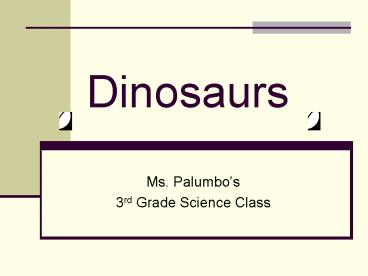Dinosaurs - PowerPoint PPT Presentation
1 / 15
Title:
Dinosaurs
Description:
The Triassic period was named in 1834 by the German geologist Friedrich ... as Stegosaurus, Ceratosaurus, Brachiosaurus, and Allosaurus walked the lands. ... – PowerPoint PPT presentation
Number of Views:211
Avg rating:3.0/5.0
Title: Dinosaurs
1
Dinosaurs
- Ms. Palumbos
- 3rd Grade Science Class
2
What are the different time periods that
dinosaurs lived in?
- The Triassic Period
- 144 to 65 Million Years Ago
- The Jurassic Period
- 206 to 144 Million Years Ago
- The Cretaceous Period
- 144 to 65 Million Years Ago
3
The Triassic Period
- The Triassic period was named in 1834 by the
German geologist Friedrich August Von Alberti - This is the first stage of the Mesozoic era which
is referred to as the age of the dinosaurs. - This period took place 248-208 million years ago.
- Pterosaurs or flying reptiles made their first
appearance here as well as frogs, turtles, and
crocodiles. - During the Late Triassic period, many small
mammals also arose.
4
Dinosaurs that roamed the earth during the late
Triassic Period
These are just two of the many dinosaurs that
were found in the late Triassic Period. In
addition to these two dinos others that were
documented included Saltopus Riojasaurus Eurapt
or
5
The Jurassic Period
- In the Jurassic period the Age of the Ruling
Reptiles began. - During this period, vegetation was greener and
more lush. - The Jurassic Period was broken up into several
sections as the chart to your left shows. - By Late Jurassic, huge dinosaurs such as
Stegosaurus, Ceratosaurus, Brachiosaurus, and
Allosaurus walked the lands. - Flying reptiles ruled the skies and the earliest
known birds also appeared.
6
- Name Means Arm Lizard
- Weight 33-88 tons
- Height 85 feet
- Was one of the tallest and longest dinosaurs
found. - It had a long neck, small head, and relatively
short, thick tail. - Brachiosaurus walked on four legs and unlike most
dinosaurs unusual front legs together with its
very long neck gave Brachiosaurus a giraffe-like
stance and great height. - was an herbivore, a plant eater
- Lived during the Jurassic period
Brachiosaurus
7
JANENSCHIA
- Length 80 feet
- Weight 33 tons
- Giant plant eating dinosaur
- Walked on four thick legs
- Janenschia and some of the other large
long-necked plant-eaters needed to have large,
powerful hearts and very high blood pressure in
order to pump blood up the long neck to the head
and brain. - Lived during the late Jurassic period, about 156
million to 150 million years ago.
8
CRETACEOUS PERIOD
- The Cretaceous period may have seen more
dinosaurs then ever before. - Horned Cretaceous dinosaurs appeared, like the
Triceratops and Centrosaurus. - The armored Ankylosaurus, duckbilled
Parasaurolophus, and large carnivore
Tyrannosaurus were a few of the quickly evolving
dinosaurs. - Birds became increasingly numerous and flowering
plants were emerging. - By the end of the Cretaceous period, all large
and small ruling reptiles, except the crocodile
went extinct. - This period is usually noted for being the last
portion of the "Age of Dinosaurs
DINOSAURS
9
Tyrannosaurus Rex
- Name Means Tyrant Lizard King
- Carnivore or Meat Eater
- Ate large dinosaurs such as Triceratops
- Length 40 feet
- Height 15 20 feet
- Weight 5 7 tons
- Lived during the Cretaceous period
- Was at the top of the food chain in his
environment - Has huge jaws, and clawed legs, but small arms
10
Name Means Three-Horned Face Length 30
feet Height 7 feet Weight 6-12 tons Lived
during Cretaceous period Was a herding
animal Plant eater Triceratops was named by
Othniel Marsh in 1889 There are about 200 bones
in the Triceratops body
Triceratops
11
Where can we still see dinosaurs today?
- Museums
- The Dinosaur Museum
- www.dinosaur-museum.org/
- Royal Tyrrell Online Museum
- www.tyrrellmuseum.com/
- The American Museum of Natural History
- http//www.amnh.org/exhibitions/Fossil_Halls/Timel
ines/index.html - http//ology.amnh.org/paleontology/index.html
12
Where can we find more information on dinosaurs?
- The Internet
- Some super websites that will help you learn
anything and everything on dinosaurs (and even
play some fun games!) - The Dinosauricon
- http//dino.lm.com/
- The Fact Monster
- http//www.factmonster.com/ipka/A0878252.html
- Dinosauria
- http//www.dinosauria.com/
- National Geographic
- http//www.nationalgeographic.com/dinoeggs/
13
Didnt find a website you liked? Try the
bookstore, library or even the classroom!
- At the bookstore
- How Do Dinosaurs Count to Ten?
- How Do Dinosaurs Get Well Soon?
- How Do Dinosaurs Say Good Night?
- Dinosaur-Sticker Book
- Dinosaur's Binkit
- Big Book of Dinosaurs A First Book for the Young
- Encyclopedia of Dinosaurs and Other Historic
Creatures - Dinosaurs (Discoveries Series)
- AND MANY, MANY MORE!
14
Dont have any money or a car just yet, why dont
you zoom down to the library, Im sure theyll
have something to check!
- Mrs. Andrews is expecting you all!
- Once you get to the library, there will be a
stack of reference sheets in our classes cubby. - Please take one and follow the directions that we
have laid out for you. - If you get stuck or confused, please see Mrs.
Andrews, she is always happy to help!
15
What is your favorite type of dinosaur?
- Triceratops
- Janenschia
- Plateosaurus
- Brachiosaurus
- Tyrannosaurus Rex
- Other




























![❤[PDF]⚡ Dinosaurs Memory Match Game (Set of 72 cards) PowerPoint PPT Presentation](https://s3.amazonaws.com/images.powershow.com/10071165.th0.jpg?_=20240703076)


